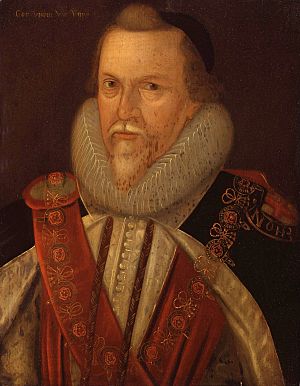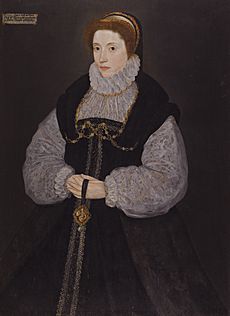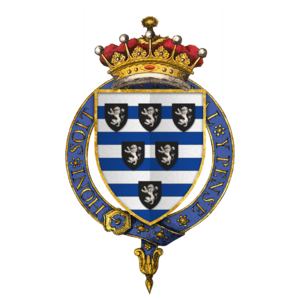Thomas Cecil, 1st Earl of Exeter facts for kids
Thomas Cecil, 1st Earl of Exeter, KG (born May 5, 1542 – died February 8, 1623), was an important English politician, courtier (someone who attends a royal court), and soldier. He was known as Lord Burghley from 1598 to 1605. Thomas Cecil played a significant role in the government during the reigns of Queen Elizabeth I and King James I. He was also known for his military bravery and for building grand homes.
Quick facts for kids
Thomas Cecil
|
|
|---|---|

Thomas Cecil, 1st Earl of Exeter
|
|
| Born | 5 May 1542 St Mary the Great, Cambridge, England |
| Died | 8 February 1623 Westminster Abbey, London, England |
| Title | Earl of Exeter |
| Tenure | 4 May 1605 – 8 February 1623 |
| Other titles | 2nd Baron Burghley |
| Nationality | English |
| Residence | Exeter House Burghley House Wimbledon Palace Wothorpe Towers |
| Spouse(s) | Dorothy Neville Frances Brydges |
| Issue | William Cecil, 2nd Earl of Exeter Lucy Cecil, Marchioness of Winchester Mildred Cecil-Trafford Sir Richard Cecil Edward Cecil, 1st Viscount Wimbledon Mary Cecil, Countess of Norwich Dorothy Cecil, Lady Alington Elizabeth Cecil, Lady Hatton Thomas Cecil Frances Cecil, Countess of Thanet |
| Parents | William Cecil, 1st Baron Burghley Mary Cheke |
|
|
|
Contents
Thomas Cecil's Family Life
Thomas Cecil was the older son of William Cecil, 1st Baron Burghley. His mother was Mary Cheke, who passed away in February 1543. Mary was the daughter of Peter Cheke, a respected official at the University. Thomas also had half-siblings, including Robert Cecil, 1st Earl of Salisbury, Anne Cecil, and Elizabeth Cecil.
At a young age, Thomas's father worried about his behavior. However, as Thomas grew older, he became a much more responsible person. He proved to be a skilled soldier and a helpful politician. He also had a big impact on the construction of important houses, including Burghley, Wothorpe Towers, and Wimbledon Palace.
Thomas Cecil's Career and Public Service
Early Education and Travel
Thomas Cecil received his education privately and later attended Trinity College, Cambridge. In 1558, he also joined Gray's Inn, a place where lawyers were trained. To further his education, he traveled to Europe in 1561–62. He spent time in Paris, Antwerp, and Germany. His travels were cut short when he was called back to England.
Serving Queen Elizabeth I
Thomas Cecil served in the government under Queen Elizabeth I of England. He was a member of the House of Commons for Stamford, Lincolnshire, in several parliaments. In 1575, he was knighted, which is a special honor given by the monarch. He also became the High Sheriff of Northamptonshire in 1578.
He showed great bravery while serving with Robert Dudley, Earl of Leicester in the Dutch Republic. In 1585, he was made governor of Brielle, an English Cautionary Town in the Netherlands. He was very loyal to Sir John Norreys.
Building Wimbledon Palace
In 1588, Thomas Cecil finished building Wimbledon Palace in Wimbledon Park, London. This grand house was a leading example of the large, impressive homes built during the Elizabethan era, known as prodigy houses.
Joining the House of Lords
After his father passed away in 1598, Thomas Cecil inherited his father's title and became the 2nd Lord Burghley. This gave him a seat in the House of Lords. From 1599 to 1603, he served as Lord Lieutenant of Yorkshire and Lord President of the Council of the North. This important office was based at the King's Manor in York. During this time, Queen Elizabeth I honored him by making him a Knight of the Garter in 1601.
Serving King James I
After Queen Elizabeth I died in 1603, James VI and I became the new King of England. Thomas Cecil, now Lord Burghley, made sure everything was ready for King James's journey south to London. He even moved out of King's Manor in York so the King could stay there. He made sure the house was well-stocked for the King's visit.
King James stayed in York for three days in April 1603. Later, the King's wife, Anne of Denmark, also visited York in June. Lord Burghley was very impressed with Queen Anne, describing her as a "magnifical prince" and a "kind wife."
Becoming Earl of Exeter
On May 4, 1605, King James I gave Thomas Cecil the new title of Earl of Exeter. On the same day, his younger half-brother, Robert Cecil, became the 1st Earl of Salisbury. Unlike his brother, Thomas Cecil did not become a government minister under King James.
Supporting the Arts
The Cecil family, including Thomas, were big supporters of the arts. They helped musicians like William Byrd, Orlando Gibbons, and Thomas Robinson. Thomas Robinson even worked for Thomas Cecil when he was younger.
Marriages and Children
Thomas Cecil was married twice. His first wife was Dorothy Neville. She was the daughter of John Neville, 4th Baron Latimer. His second wife was Frances Brydges. She was the daughter of William Brydges, 4th Baron Chandos.
With his first wife, Dorothy, Thomas Cecil had ten children who grew up to be adults:
- William Cecil, 2nd Earl of Exeter
- Lady Lucy Cecil
- Lady Mildred Cecil
- Sir Richard Cecil
- Edward Cecil, 1st Viscount Wimbledon
- Lady Mary Cecil
- Lady Dorothy Cecil
- Lady Elizabeth Cecil
- Thomas Cecil
- Lady Frances Cecil
His second wife, Frances, was about 30 years old when she married Thomas Cecil in 1609, who was 70 at the time. They had one daughter, Georgiana, who was born in 1616. Queen Anne, King James I's wife, was Georgiana's godmother. Sadly, Georgiana passed away in 1621.
Thomas Cecil, the Earl of Exeter, died on February 7, 1623. He was buried in the chapel of St John the Baptist, located in Westminster Abbey, London.
|
| Political offices | ||
|---|---|---|
| Preceded by creation |
Governor of Brill, The Netherlands. bef. 1585 – aft. 1596 |
Succeeded by Sir Edward Conway |
| Preceded by The Lord Burghley |
Custos Rotulorum of Lincolnshire bef. 1594 – aft. 1608 |
Succeeded by Lord Burghley |
| Preceded by Kenelm Digby |
Custos Rotulorum of Rutland bef. 1594–1623 |
Succeeded by The Marquess of Buckingham |
| Vacant
Title last held by
The Earl of Huntingdon |
Lord Lieutenant of Yorkshire 1599–1603 |
Succeeded by The Lord Sheffield |
| Vacant
Title last held by
Sir Christopher Hatton |
Lord Lieutenant of Northamptonshire 1603–1623 |
Succeeded by The Earl of Exeter |
| Peerage of England | ||
| New creation | Earl of Exeter 1605–1623 |
Succeeded by William Cecil |
| Preceded by William Cecil |
Baron Burghley 1598–1623 |
|
See also
Wimbledon Palace - The house Sir Thomas Cecil built



